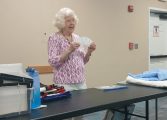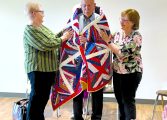“We were working very hard and planning for tomorrows that were not guaranteed,” Mink said. They decided to live six months of the year at home and six months in other locations. Their goal was to be in each of the locations that they chose long enough to get a real feel for the place, its people and its culture. Naturally, they visit the tourist attractions but don’t rush through them.
Instead, they visit several times and attend local events, festivals and other activities.
“Of course the first question is, ‘How can you afford this?’” Mink said. “We have been blessed, but we’ve also worked very hard throughout our lives. Al retired as a colonel in the Air Force, so we have military retirement and the health care that goes with it.” They also have savings and investments, including rental properties, plus income from his consulting and her writing. “We are also frugal people. We’re not interested in designer clothing, fancy cars or the latest gadgets. With careful management, we’re finding that this lifestyle is possible.”
To do this they travel off season, avoiding summer and holidays. Traveling during the off-peak times usually makes it easier to negotiate a lower rate for a long-term rental flat, Mink said. “This is because the landlord knows that he or she will have a guaranteed income during the entire slow season and will be happier to work with you. The off-peak travel times vary due to location, but usually they are in early spring and late fall, so that’s when we tend to plan our travel.”
Transportation is a consideration when the Minks choose a location. This usually means a city location but she cautioned that the cost of city living is more expensive and the environment is noisier.
“We’ve generally avoided the very centers of the tourist areas for several reasons. First off, they are usually the most expensive accommodations you can find for a short-term rental. Secondly, because it’s often the area with entertainment, nightclubs and bars, it can be noisy at night, making it difficult to sleep,” she said. “Each city is different, but we generally try to look for an upper class residential area that is walkable to the city center or is conveniently served by public transportation.”
They have used HomeAway.com and Airbnb to begin their search for long-term rentals. Mink says it’s a good place to get an idea of the cost, the locations that are available, and the services and fees that are usual for the area, as these vary from place to place.
“HomeAway does a very good job of making the locations and additional fees clear. If you find places that look as though they will work for you, message more than one of them,” she said.
When it comes to negotiating the terms of the rental, the Minks admit they have gotten as much as a 25 percent discount by asking. They encourage people to ask for a better deal.
“Don’t be shy negotiating – this is the part of the process where you can save the most money. If they won’t negotiate, move on,” she said.
Once they arrive, they look for activities and events within the community. Mink found a knitting group through the local yarn shop while her husband found biking clubs through the local bike store. They discover lectures on history and art through museums and libraries, provided they are in English. They ask the locals for the location of hidden notable landmarks worth exploring.
“We loved York because it was very accessible with the language, the people were warm and welcoming, and the city was very charming. It had lots of little secrets that you find out as you live there. For instance, there are little hidden cat sculptures all over the city on the walls and light posts – it took me nearly two months to notice them. There are wonderful little events like teas and little fairs that anyone can attend,” Mink said.
“Florence was spectacular – the art was everywhere and overwhelming and the food was incredible. It was crowded and crazy but that was part of the fun. I also loved the street signs. There’s an artist who lives in Florence who changes the street signs into art – they’re wonderful,” she said. What struck Mink about most places she visited is that she couldn’t help but learn more of the history since it surrounded her everywhere she went.
“In a more cosmic sense, we learned to slow down and take things in,” Mink said. “Even in busy Florence, people live at a slower pace. We’ve learned to open ourselves up to new experiences and not be afraid to try new things. We also learned to be bolder, introduce ourselves and make the first move to meet people.”
One of the main differences between America and other places Mink has visited is that European cities were built before cars, so there’s no room for parking or for cars passing on the street. As a result, they are not allowed.
“And that’s wonderful – people walk everywhere. I think that might be why they are fit,” she said. “One of the great things in England is that there are pathways all over the country that anyone can walk on, through private land, but you can walk anywhere because of them. They go through backyards, cow fields, gardens – if they are there, landowners can’t keep people off of them. They are well-marked and safe, and allow you to walk anywhere you’d like to go.”
In Italy, the people were generally warm and happy, Mink said, but took their work and crafts seriously. When they ordered a meal in an authentic Italian restaurant, not a tourist place, they didn’t dare ask for an ingredient to be left out or for the food to be cooked differently. “They have real respect for the integrity of the food, and they would politely suggest you order something different because they had crafted the food to taste the very best the way they made it,” Mink said. “They were the same way about other things – they approach their work as art, with a true respect for the product, the process.”
Mink said she hears excuses for why some would like to do what they do, but don’t. Most often people cite leaving pets, missing their friends and relatives, and the cost of travel.
“I think the biggest thing is just to decide you’ve got one shot in life, this is what you want, you’re going to do it and then go ahead. The worst that can happen is that you go to a place you don’t like and you come home early,” she said. “There are a lot of details to figure out – how do you get your mail, what to pack, et cetera, but we’re working on a blog that will include that information.”
She also suggested a website called Digital Nomads –another name for people who work all over the world – that offers a lot of suggestions. “It helps match you to places you might like, offers suggestions on some of the mundane questions like visas and shots and such, and helps you connect with a community once you get to where you’re going,” she said.
“It was scary at first to do this – and quite honestly, each time we pack to go, we look at each other and ask if we really want to do this. It’s a lot easier just to stay home. But our lives are so much richer, so much fuller for this, and once we get to our new temporary home, we’re so glad we’re there. By the time it’s time to leave, it’s bittersweet to say goodbye,” she said. Their next three-month stint will be in August in Krakow, Poland.




